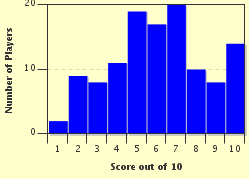Quiz Answer Key and Fun Facts
1. For many, the first decision point is whether to plant hybrid, heirloom or both. What is a disadvantage of heirloom tomato plants?
2. If I decided to grow a single tomato in a container on the tiny balcony of the second floor, which of these varieties would be a primary choice?
3. Another decision is whether to start from seed or seedlings. If you're planning to start from seeds, when should you start them?
4. The garden plot will need to be prepared. The plot should generally be located in a spot with eight hours of daily sun. When the soil is tested for pH, what values would be optimal?
5. Finally, it's time to plant the tomatoes in the garden plot. Which of these techniques can be used to help prevent a temperature change from shocking the plants?
6. Once the plants are in the ground, many gardeners support the plants by staking, caging or trellising. Which of these would NOT be considered a reason to support the plants?
7. Water the new plants well to reduce the possibility of transplant shock. The plants will need to be watered regularly, but the pattern of watering will depend greatly on your specific climate. It is also recommended that mulch be added several weeks after the plants go in the ground. Which of these is an advantage to using mulch?
8. Tomatoes are popular and generally easy to grow, but they can have problems due to nutrient deficiency, disease and insects. Which of these is NOT recommended to limit problems with your plants?
9. It is often recommended that fertilizers be used to ensure the best yields for tomato plants. Which of these should be avoided while fertilizing?
10. To prune or not to prune, that is the controversy. If you do prune, what is the term for what you are removing from the plant?
Source: Author
mlcmlc
This quiz was reviewed by FunTrivia editor
WesleyCrusher before going online.
Any errors found in FunTrivia content are routinely corrected through our feedback system.

